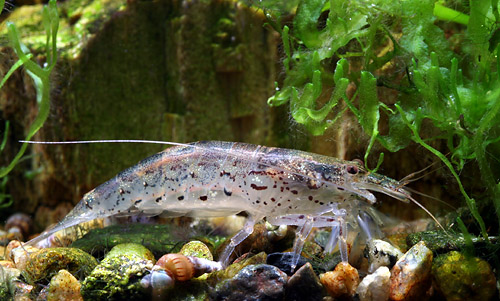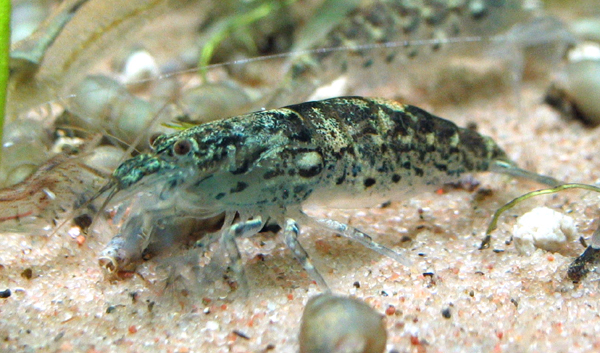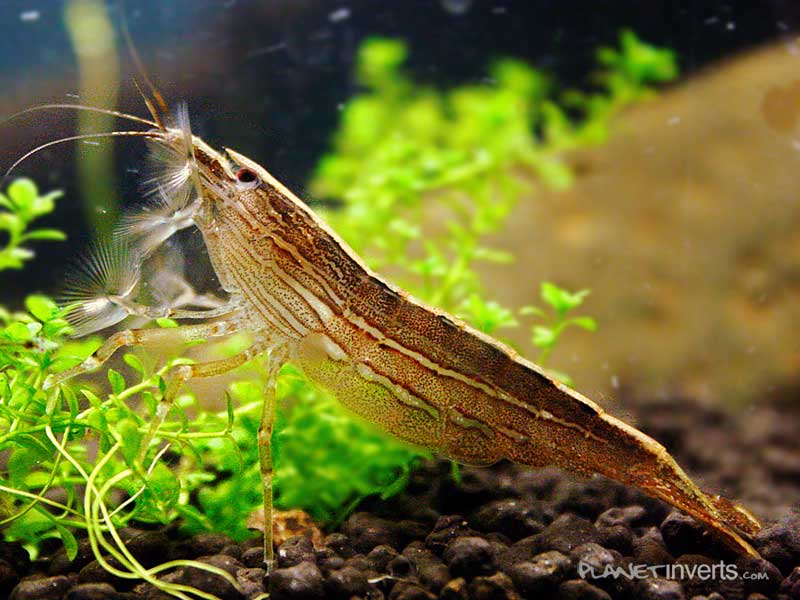Atyopsis
Moluccan Fächergarnele ( Atyopsis moluccensis )
Called the Molucca Fächergarnele ( Atyopsis moluccensis ), also Molucca mountain stream Shrimp or Radargarnele, is an Asian freshwater shrimp.
Occurrence
The species is in South and Southeast Asia spread from India and Sri Lanka on Thailand and the Malay Peninsula, Indonesia to New Guinea. It was named after the Indonesian archipelago of the Moluccas.
Features
The animals are up to 8.6 cm long and are very variable in color. The base color ranges from light to dark brown, as a drawing come before dark line or interrupted pattern; There are also copies with a light dorsal stripe. Earlier specimens from different regions were incorrectly assigned to different species. Subjects shrimp do not reproduce in captivity and the classification of the color types for common type was relatively late.
Ingestion
Like all subjects shrimp has Atyopsis moluccensis long bristles on the first two pairs of walking legs, which are used for filtering plankton. You are in the active state unfolds like a fan, be kept in the flow and periodically drawn together under the body stripped. The ausfiltrierten micro- organisms are absorbed by the shrimp. The sensitive bristle apparatus is frequently cleaned and sorted.
The two compartments pairs of legs are used for locomotion and for supporting, the bristles are then folded into small, tapered cones. When swimming, the legs are kept tightly under the body.
Way of life
The adults live in flowing waters and prefer locations with very strong currents. Young animals live in areas with on calmer waters. The species occurs in spite of the trivial name Molucca mountain stream Shrimp only in warm waters in the lowlands and not in the mountains.
Reproduction
The details of the reproduction are unknown. Presumably the larvae migrate downstream and develop in seawater or brackish water before they change back into freshwater. This behavior is shown by many freshwater shrimp species whose larvae are dependent in the first weeks of life to a minimum salt content. They originate from a purely evolutionary meeresbewohnenden types, not all lines of development have acquired the ability to reproduce in freshwater. Possible reasons for the need for salt in the first weeks of life, peculiarities in the metabolism and, in particular processes during molting in the larval stage are discussed. A successful breeding in captivity has been reported.
Subjects shrimp in the aquarium
The Animals - marketed commercially as Fächerhandgarnele - are often kept in aquariums. However, they make special demands on the housing conditions, strongly prefer moving water with a high percentage suspended solids, including algae and animal micro- organisms. An optimal feeding in captivity is considered difficult, especially schwebstoffreiches or cloudy water is often undesirable. Constant optimal conditions can be produced in captivity only by constant small lining gifts, because the composition of aquarium water must be regulated in a closed circuit with filters which extract the water resistant also the food of shrimp. Caught held fan shrimp tend sometimes to Gründeln in the soil substrate or take sessile organisms feed on, which is not known to what extent they exhibit this behavior in the wild.










